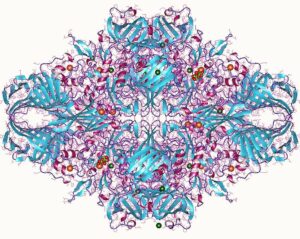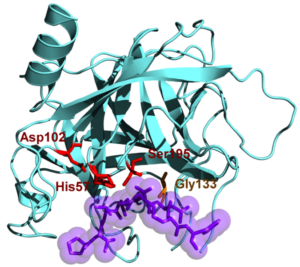Catabolic enzymes facilitates the digestion of food materials by converting the large molecules into small molecules.The catabolic enzymes convert the complex molecules into the simple molecules by breaking down the bonds between them.
The catabolic enzymes play a crucial role in digestion process.
- Lactase
- Diastase
- Sucrase
- Maltase
- Glucoamylase
- Protease
- Lipase
- Cellulose
Lactase:
It is producedin a great number of organisms especially in mammals. It can also be termed as lactase- phlorizin hydrolase and it comes under β- galactosidase family. It can be found at the brush boarder of the small intestine in humans and mammals. Lactase breaks down the whole milk into simple sugar lactose which is the sweeting component of milk.
If the person lacks lactase enzyme he/ she is intolerant to lactose products like milk, cheese, butter, curd etc.
The person cannot digest them easily and may get gas, and diarrhoea.

Diastase:
It can break down the polysaccharide into monosaccharaides. It is group of amylase enzyme usually it converts starch into maltose during germination of seeds. It is found in germinating seeds, saliva, and digestive tract of humans and also in honey.
Sucrase:
This enzyme can also termed as invertase. It is generally found in yeast, brush boarder of the small intestine in humans and in the intestinal mucosa of animals. This enzyme digests the sucrose into simple sugars like glucose and fructose. In the absence of sucrase enzyme some sugars like sucrose are not digested.
Maltase:
It breaks down the maltose into glucose molecule. It is commonly found in plants, bacteria, humans, and in yeast.
Glucoamylase:
It hydrolyses the starch. It is generally used in food processing industry for fermentation of starch or dextrin and in beverage production. It acts as a bio catalyst by converting polysaccharide sugars into monosaccharide sugars. The dextrose and isomaltose are formed in reverse reaction of glucoamylase by combining the dextrin molecules.
The microorganisms like aspergillus neiger, aspergillus awamori and rhyzophus oryzae can produce glucoamylase.
It can be seen in humans especially in mouth and pancreas.
Protease:
The proteins are digested by protease by hydrolysis of protein bonds.
These are produced in plants, animals, humans, fungi, and bacteria, especially in human body they are produced in pancreas and stomach. These enzymes usually aid the digestion of dairy products like cheese, milk, butter and meat products.
They can also help in the cell division process, immune system maintenance, blood clotting, and protein recycling process.
Not only humans but also plants need proteolytic enzymes for the growth and development.
There are three types of proteases. They are trypsin, pepsin, and chymotrypsin. These enzymes break down the large protein chain into simple amino acids by digesting protein bonds.
These enzymes are produced in our body and some food items like papaya, pine apple, ginger, kiwifruit, and yogurt are the natural sources of peptidases.

Lipase:
Lipases breakdown the lipids and fats into small fatty acids. For example triglycerides are converted into glycerol and fatty acids by breaking down the corboxy ester bonds. The glycerol and fatty acids can be easily absorbed by the body.
In human body mouth, pancreas, and stomach produce this enzyme.
Lipase is used in vegetable oil production and baking as well as dairy industries to amplify the aroma.
Celluase:
It hydrolyses the plant polysaccharide product cellulose into monosaccharide glucose. Cellulose is plant fiber and cannot be digested easily. It hydrolyses cellulose by breaking down the β-1, 4 – glycosidic bonds. It can act against the harmful microbial biofilm and enhance the release of antioxidant components in fruits and vegetables.
Conclusion:
The catabolic enzymes play a crucial role in the catabolism of food items like carbohydrates, proteins, lipids and fats by hydrolysing the bonds. they convert large molecules into simple compounds. Thus the catabolic enzymes are very important in biological system.
Also Read:
- Sequence of nitrogenous bases in dna
- Horseshoe crab characteristics
- Are diatoms protists 2
- Can enzymes be reused
- Is enzyme a protein
- Cytoskeleton function
- Do bacteria have mitochondria
- Digestive enzyme example
- Contractile vacuole in amoeba
- Protein synthesis in endoplasmic reticulum

Hi…I am Nagasrilakshmi Narne, a postgraduate in Biotechnology and English. also completed my B.Ed. I worked in Vimtalabs as a project trainee and I have work experience as a faculty of English. So I can explain topics in simple language.
Let’s connect through LinkedIn